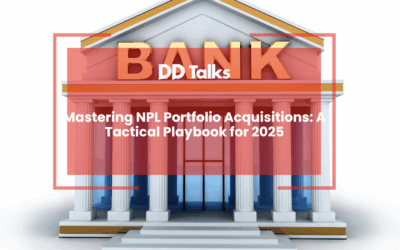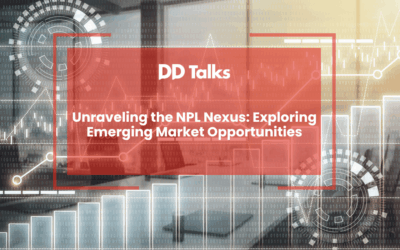Key Takeaways
- The European NPL market in 2025 shows significant growth in Southern Europe, with Italy and Spain leading with portfolios exceeding €200 billion, while emerging opportunities exist in Central and Eastern European markets.
- Effective NPL due diligence requires comprehensive data analysis, portfolio segmentation, jurisdiction-specific legal assessment, and evaluation of servicing capabilities to accurately value distressed assets.
- NPL valuation combines multiple methodologies including DCF analysis, statistical recovery models, comparative transaction analysis, and scenario-based approaches to determine accurate pricing.
- Successful NPL bidding strategies incorporate tiered pricing, consortium formation, seller motivation analysis, and innovative deal structuring to gain competitive advantages.
- Deal structuring options range from direct asset acquisitions to securitization frameworks, forward flow agreements, and joint ventures, each offering different risk-return profiles.
- NPL financing typically employs layered capital structures combining senior debt (50-65% of purchase price), mezzanine financing (10-20%), and equity arrangements to optimize returns.
- Co-investment vehicles like limited partnerships, joint ventures, and club deals enable investors to share risk while leveraging complementary expertise across jurisdictions.
- Post-acquisition management success depends on strategic servicing decisions, portfolio segmentation, technology infrastructure, and clear exit planning to maximize recovery value.
Table of Contents
- Understanding the European NPL Market Landscape in 2025
- Essential NPL Due Diligence: Building Your Acquisition Framework
- NPL Valuation Methods: From Discounted Cash Flow to Recovery Models
- How Can Investors Optimize NPL Bidding Strategies?
- Structuring NPL Deals: Legal Frameworks and Transaction Models
- NPL Financing Solutions: Leveraging Debt and Equity Options
- Co-Investment Vehicles for NPL Acquisitions: Sharing Risk and Reward
- Post-Acquisition NPL Portfolio Management Best Practices
Understanding the European NPL Market Landscape in 2025
The European non-performing loan (NPL) market continues to evolve significantly as we approach 2025, presenting both challenges and opportunities for investors. Current market trends indicate a resurgence in NPL volumes across several key European markets, particularly in Southern Europe where economic pressures have intensified following recent fiscal adjustments.
Italy and Spain remain dominant players in the NPL space, with combined portfolios exceeding €200 billion. However, emerging opportunities in Central and Eastern European markets—notably Poland, Romania, and Greece—are attracting increased investor attention due to their maturing regulatory frameworks and improving recovery mechanisms.
Regulatory developments continue to shape the landscape, with the European Banking Authority’s guidelines on NPL management becoming increasingly stringent. Banks face mounting pressure to reduce NPL ratios below 5%, accelerating portfolio disposals and creating a buyer’s market in certain segments. The implementation of the EU’s NPL Directive has standardised aspects of NPL transactions, improving market transparency and facilitating cross-border acquisitions.
Asset class diversification within NPL portfolios has become more pronounced, with corporate, SME, and secured retail exposures dominating transaction volumes. The post-pandemic economic environment has particularly affected commercial real estate portfolios, creating specialised acquisition opportunities for investors with sector expertise.
Essential NPL Due Diligence: Building Your Acquisition Framework
Effective due diligence forms the cornerstone of successful NPL portfolio acquisitions. A robust due diligence framework must encompass multiple dimensions to accurately assess portfolio value and identify potential risks. The process begins with comprehensive data room analysis, where investors must scrutinise loan documentation, collateral valuations, and historical recovery patterns.
Portfolio segmentation represents a critical component of the due diligence process. Investors should categorise loans based on multiple parameters including asset class, vintage, geographical distribution, and enforcement status. This granular approach enables more accurate valuation and identifies high-potential recovery segments within larger portfolios.
Legal due diligence requires particular attention in the European context, where enforcement regimes vary significantly across jurisdictions. Investors must evaluate enforceability of security interests, potential legal impediments to collection, and the efficiency of local court systems. In markets like Italy and Greece, where judicial processes remain protracted, understanding procedural timelines is essential for accurate cash flow modelling.
Servicing capabilities assessment constitutes another vital element of the due diligence framework. Evaluating existing servicing arrangements or potential servicing partners involves analysing operational capacity, technological infrastructure, and track record in similar portfolios. Institutional investors typically maintain relationships with multiple servicers to optimise portfolio management across different asset classes and jurisdictions.
Finally, macroeconomic analysis must inform the due diligence process, with particular focus on regional economic indicators, property market trends, and employment statistics that may impact recovery rates. Forward-looking stress testing under various economic scenarios provides valuable insights into portfolio resilience and potential downside risks.
NPL Valuation Methods: From Discounted Cash Flow to Recovery Models
NPL portfolio pricing requires sophisticated valuation methodologies that account for the complex nature of distressed assets. Discounted Cash Flow (DCF) analysis remains the foundation of NPL valuation, where projected recovery cash flows are discounted at risk-adjusted rates reflecting portfolio characteristics. However, the accuracy of DCF models depends heavily on the quality of underlying assumptions regarding recovery timing, costs, and rates.
Statistical recovery models have gained prominence, particularly for larger, granular portfolios. These models leverage historical performance data to predict recovery outcomes across different loan segments. Machine learning algorithms increasingly enhance these models by identifying non-obvious correlations between loan characteristics and recovery patterns, improving predictive accuracy.
Comparative transaction analysis provides valuable benchmarking for portfolio pricing. By analysing recent comparable transactions in similar jurisdictions and asset classes, investors can establish pricing parameters and identify potential arbitrage opportunities. However, the idiosyncratic nature of NPL portfolios necessitates adjustments for specific portfolio characteristics.
Collateral valuation methodologies vary by asset class but typically involve haircuts to current market values based on liquidation scenarios. For real estate collateral, investors must consider location-specific factors, property condition, and local market liquidity. Advanced geospatial analysis tools now enable more precise property valuations across diverse geographical locations.
Scenario-based valuation approaches have become increasingly important in the volatile economic environment. By modelling multiple recovery scenarios with assigned probabilities, investors can develop more robust pricing models that account for macroeconomic uncertainties and regulatory changes. This approach is particularly valuable for portfolios with significant exposure to cyclical sectors or volatile regions.
How Can Investors Optimize NPL Bidding Strategies?
Developing effective NPL bidding strategies requires a multifaceted approach that balances competitive positioning with risk management. Successful bidders typically employ tiered pricing strategies that differentiate between high-quality and more challenging assets within portfolios. This granular approach enables more aggressive bidding on premium segments whilst maintaining appropriate caution on riskier exposures.
Consortium bidding has emerged as a prevalent strategy, particularly for larger transactions exceeding €500 million. By forming strategic partnerships with complementary investors, bidders can leverage combined expertise across different asset classes and jurisdictions. Consortium structures also facilitate risk sharing and enable participants to access transactions that might otherwise exceed individual investment parameters.
Seller motivation analysis provides critical insights for bid optimisation. Understanding whether a sale is driven by regulatory pressure, capital optimisation, or strategic refocusing enables bidders to tailor their approach accordingly. Regulatory-driven sales often present opportunities for more aggressive pricing, particularly when approaching reporting period deadlines.
Pre-emptive bidding strategies can prove highly effective in competitive markets. By submitting compelling initial offers with limited conditionality, investors can sometimes secure exclusivity before broader auction processes commence. This approach requires confidence in valuation and typically demands premium pricing, but can substantially reduce execution risk and transaction costs.
Bid structuring flexibility represents another key competitive advantage. Offering sellers alternative transaction structures—such as joint ventures, servicing partnerships, or phased acquisitions—can differentiate bids beyond pure pricing considerations. Innovative profit-sharing mechanisms or earnout structures can bridge valuation gaps whilst providing sellers with potential upside participation.
Structuring NPL Deals: Legal Frameworks and Transaction Models
NPL deal structuring encompasses various legal frameworks and transaction models tailored to specific portfolio characteristics and investor objectives. The choice between asset deals (direct loan acquisitions) and share deals (acquisition of entities holding NPLs) carries significant implications for taxation, regulatory requirements, and operational flexibility. Asset deals predominate in most European markets, offering cleaner execution and targeted portfolio selection.
Securitisation structures have gained prominence, particularly in Italy through the GACS scheme and in Greece with the Hercules programme. These government-backed securitisation frameworks provide credit enhancement through state guarantees on senior tranches, improving financing terms and expanding the investor base. Multi-tranche structures enable risk stratification, allowing different investor types to participate according to their risk appetite.
Forward flow agreements represent an emerging transaction model, particularly suitable for ongoing NPL generation. These arrangements establish predetermined pricing mechanisms and transfer parameters for future NPL production, providing sellers with certainty while offering buyers consistent acquisition pipelines. Pricing typically incorporates adjustment mechanisms based on portfolio composition and performance metrics.
Joint venture structures between sellers and investors have become increasingly common, particularly for complex corporate exposures or specialised asset classes. These arrangements allow banks to maintain involvement in the workout process while transferring risk and leveraging investor expertise and capital. Governance frameworks for such structures require careful design to align incentives and establish clear decision-making protocols.
Legal documentation standardisation has advanced significantly, with market participants increasingly adopting common frameworks for loan sale agreements, servicing arrangements, and warranty provisions. Nevertheless, jurisdiction-specific considerations remain critical, particularly regarding data protection regulations, consumer protection laws, and enforcement procedures. Regulatory approvals vary substantially across European markets, with certain jurisdictions requiring specific licences for NPL acquisition and management.
NPL Financing Solutions: Leveraging Debt and Equity Options
Financing NPL acquisitions requires sophisticated capital structures that optimise returns while managing risk exposure. Senior debt financing remains available for high-quality secured NPL portfolios, typically covering 50-65% of purchase price with pricing ranging from 300-500 basis points over reference rates. Lender appetite varies significantly by jurisdiction, with stronger financing terms available in markets with established enforcement frameworks like Spain and Ireland.
Mezzanine financing bridges the gap between senior debt and equity, typically covering an additional 10-20% of acquisition costs. These instruments often incorporate profit participation features through payment-in-kind interest or equity kickers, aligning lender returns with portfolio performance. Specialised credit funds and certain investment banks have emerged as key providers of mezzanine capital for NPL transactions.
Vendor financing has become increasingly prevalent, particularly in larger transactions where sellers seek to facilitate execution. These arrangements typically involve deferred payment components or seller notes, sometimes with performance-based adjustments. Vendor financing can effectively bridge valuation gaps and demonstrates seller confidence in portfolio quality, though investors must carefully assess the implications for overall returns.
Equity structuring for NPL investments often involves tiered capital arrangements with differentiated risk-return profiles. Preferred equity structures with priority distributions have gained popularity among more conservative institutional investors seeking downside protection. Conversely, carried interest mechanisms incentivise operating partners and asset managers through disproportionate upside participation once threshold returns are achieved.
Warehouse financing facilities enable investors to accumulate smaller portfolios before executing larger, more efficient financing arrangements. These revolving structures provide flexibility for opportunistic acquisitions and portfolio aggregation strategies. Leading investment banks now offer dedicated NPL warehouse lines with pre-agreed terms and conditions, streamlining the acquisition process for established investors.
Co-Investment Vehicles for NPL Acquisitions: Sharing Risk and Reward
Co-investment vehicles have emerged as sophisticated structures for NPL acquisitions, enabling diverse investor participation while optimising governance and alignment. Limited partnership structures remain the dominant vehicle for institutional co-investment, typically featuring committed capital from multiple investors with a specialised asset manager serving as general partner. These arrangements provide clear governance frameworks with established distribution waterfalls and reporting protocols.
Joint venture co-investment models facilitate strategic partnerships between investors with complementary capabilities. For instance, local investors with jurisdictional expertise frequently partner with international capital providers, combining market knowledge with financial resources. These arrangements typically incorporate detailed operating agreements defining decision-making authorities, capital contribution obligations, and profit-sharing mechanisms.
Club deal structures bring together smaller groups of sophisticated investors for specific transactions, often without third-party management. These arrangements feature more collaborative governance with major decisions requiring consensus among participants. While offering greater investor control, club deals demand more active involvement and typically work best among investors with established relationships and aligned investment philosophies.
Syndication platforms have developed to facilitate broader participation in NPL investments, particularly for mid-sized transactions. These platforms, often operated by investment banks or specialised intermediaries, enable investors to participate in transactions with smaller ticket sizes while benefiting from professional structuring and management. Standardised documentation and established operational frameworks reduce transaction costs and accelerate execution.
Regulatory considerations significantly impact co-investment vehicle structuring, with AIFMD compliance requirements applying to many European NPL investment platforms. Tax-efficient jurisdictions like Luxembourg and Ireland host the majority of regulated co-investment vehicles, offering established legal frameworks and double taxation treaties. Governance structures must address potential conflicts of interest, particularly when co-investors participate across different parts of the capital structure or maintain relationships with service providers.
Post-Acquisition NPL Portfolio Management Best Practices
Effective post-acquisition management determines the ultimate success of NPL investments, requiring systematic approaches to maximise recoveries while managing costs. Servicing strategy development represents the first critical step, involving decisions regarding in-house capabilities versus external servicing partnerships. Leading investors typically employ hybrid models, maintaining core asset management functions internally while leveraging specialised servicers for specific asset classes or jurisdictions.
Portfolio segmentation for workout purposes enables tailored approaches based on borrower characteristics, collateral quality, and recovery potential. High-value exposures typically warrant bespoke strategies with dedicated workout specialists, while more standardised approaches can be applied to homogeneous retail portfolios. Advanced analytics increasingly inform segmentation decisions, identifying clusters with similar characteristics and optimal resolution approaches.
Technology infrastructure has become a competitive differentiator in NPL management, with leading investors deploying specialised loan management systems that integrate collection activities, legal proceedings, and performance monitoring. Data visualisation tools provide real-time insights into portfolio performance, enabling proactive intervention when recovery trajectories deviate from projections. Workflow automation increasingly streamlines routine processes, reducing operational costs while improving consistency.
Legal enforcement strategies require careful calibration, balancing recovery maximisation with cost management. Successful investors develop jurisdiction-specific playbooks that account for local procedural requirements and timelines. Alternative resolution approaches, including consensual settlements and debt restructuring, often yield superior outcomes compared to protracted legal proceedings, particularly for corporate exposures with viable underlying businesses.
Exit strategy planning should commence from acquisition, with clear timelines and performance thresholds for portfolio disposal. Secondary market transactions provide liquidity for performing or re-performing assets, while securitisation offers exit options for larger, more granular portfolios. Asset-specific strategies, particularly for real estate collateral, may involve property refurbishment and repositioning to maximise value prior to disposal. Performance monitoring frameworks should track progress against business plans, with regular valuation updates and cash flow reconciliations to identify potential issues early.
Frequently Asked Questions
What are the biggest European NPL markets in 2025?
Italy and Spain remain the dominant players in the European NPL market in 2025, with combined portfolios exceeding €200 billion. Emerging opportunities are also developing in Central and Eastern European markets, particularly in Poland, Romania, and Greece, which are attracting increased investor attention due to maturing regulatory frameworks and improving recovery mechanisms.
What valuation methods are most effective for NPL portfolios?
The most effective NPL valuation methods include Discounted Cash Flow (DCF) analysis as the foundation, statistical recovery models enhanced by machine learning algorithms, comparative transaction analysis for benchmarking, collateral-specific valuation methodologies with appropriate haircuts, and scenario-based approaches that model multiple recovery outcomes with assigned probabilities to account for economic uncertainties.
How can investors structure NPL acquisitions?
Investors can structure NPL acquisitions through various models including: asset deals (direct loan acquisitions) versus share deals (acquiring entities holding NPLs), securitization structures (particularly government-backed schemes like GACS in Italy and Hercules in Greece), forward flow agreements for ongoing NPL generation, and joint venture structures between sellers and investors that allow for shared expertise and risk.
What financing options are available for NPL investments?
Financing options for NPL investments include senior debt (typically covering 50-65% of purchase price), mezzanine financing (covering an additional 10-20% with profit participation features), vendor financing provided by sellers, tiered equity structures with differentiated risk-return profiles, and warehouse financing facilities that enable investors to accumulate smaller portfolios before executing larger financing arrangements.
What are the essential components of NPL due diligence?
Essential NPL due diligence components include comprehensive data room analysis of loan documentation and collateral valuations, portfolio segmentation by asset class and other parameters, jurisdiction-specific legal due diligence to evaluate enforceability and procedural timelines, servicing capabilities assessment to evaluate operational capacity, and macroeconomic analysis focusing on regional indicators that may impact recovery rates.
How do co-investment vehicles work for NPL acquisitions?
Co-investment vehicles for NPL acquisitions operate through several structures: limited partnership arrangements with multiple investors and a specialized asset manager, joint ventures between partners with complementary capabilities, club deals among smaller groups of sophisticated investors, and syndication platforms that facilitate broader participation with smaller ticket sizes. These vehicles distribute risk while combining expertise and capital resources.
What are best practices for post-acquisition NPL portfolio management?
Best practices for post-acquisition NPL management include developing a tailored servicing strategy (often using hybrid models), implementing strategic portfolio segmentation for workout purposes, deploying specialized technology infrastructure for loan management, calibrating legal enforcement strategies by jurisdiction, and planning exit strategies from acquisition with clear timelines and performance thresholds for portfolio disposal.




0 Comments